Money, messaging and the big unknown — turnout — underpin Nevada’s Senate race
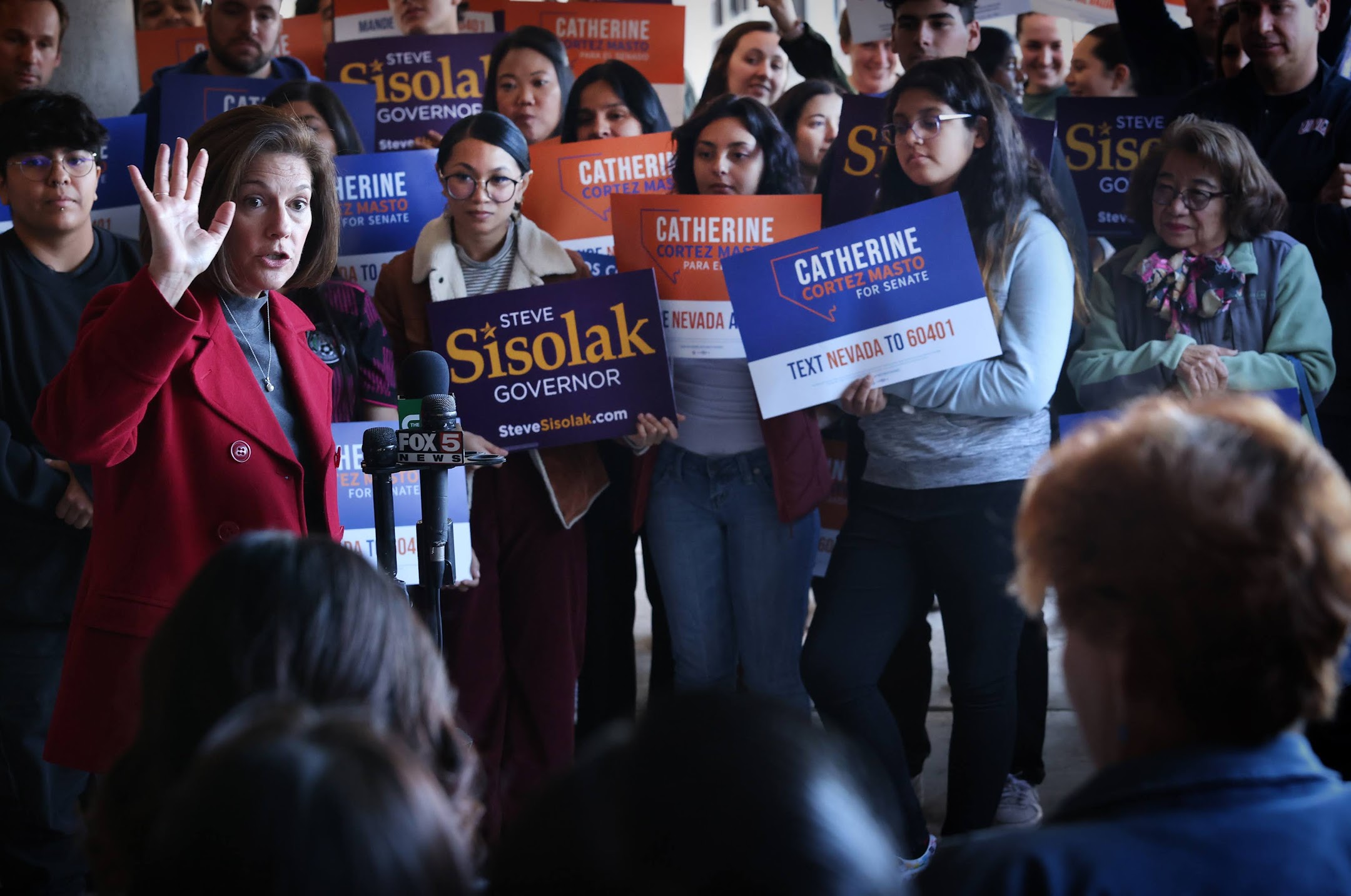
On a chilly morning in an east Las Vegas strip mall, Democratic Sen. Catherine Cortez Masto made a pitch she’s made dozens, if not hundreds, of times in the past few months:
“This is our moment.”
“Everybody has a responsibility now to turn it out,” Cortez Masto said, flanked by singer Camila Cabello and actress Kerry Washington at a Democratic field office on Friday, the state’s last day of early voting. “Because this is about our state, our future, our families, our opportunity.”
An hour away, her Republican opponent, former attorney general Adam Laxalt was meeting and greeting supporters in rural Pahrump, where his two week-long bus tour across the state’s vast rural interior was finally winding its way back to populous Las Vegas.
Just beyond the bus lay a cardboard sign:
“Destroying America’s middle class,” it read, with another cardboard cutout of President Joe Biden and Cortez Masto reading in all caps “we did that!” zip-tied beside it.
“We will never have a shot like this to take back our state,” Laxalt said later, during a campaign stop in Henderson on Friday. “We need you to be part of saving Nevada, and saving America.”
For months, Cortez Masto and Laxalt have been locked in one of the tightest electoral contests in the country, a historically expensive race billed as one of the Republican Party’s best chances to flip a seat and regain control of the U.S. Senate — and one of the Democratic Party’s last bastions of hope to keep control of it amid expectations of resurgent Republicans taking the House.
In what has become a fight for political survival for Cortez Masto and a chance to finally re-enter electoral politics for Laxalt, who last ran and lost a bid for governor in 2018, the 2022 midterms have emerged as a grueling slog fought through tens of millions of dollars in advertising spending that have blanketed airwaves with nonstop attacks.
On the trail, each candidate has adhered to packed schedules of dozens of small events, criss-crossing the state for meet-and-greets, town halls, fundraisers and get-out-the-vote rallies, with both candidates doubling down on their messages during Nevada’s two weeks of early voting.
Cortez Masto — a former attorney general who was elected to replace outgoing Sen. Harry Reid in 2016 — has cast her campaign as a bulwark for abortion access rights in the wake of the end of Roe v. Wade.
In Congress and now on the trail, she has sought to walk the path of the bipartisan moderate Democrat — backing the Biden White House on key economic legislation while breaking with the administration elsewhere, including, notably, a progressive push to reform mining taxes and balking at a plan to lift Title 42, a Trump-era limit on asylum seekers implemented during the pandemic.
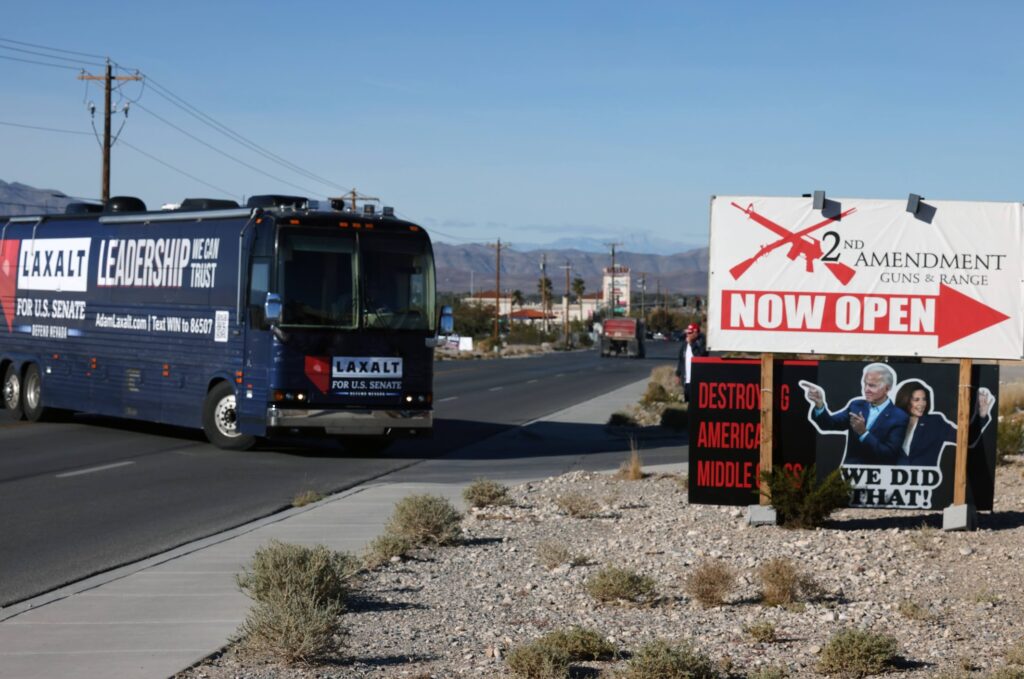
Laxalt, by contrast, has run a campaign as the conservative stalwart, a counter to what he has described as the “radical leftist” Cortez Masto. Since launching his campaign last year, he has railed against Democratic “open border” policies and sought to tie Cortez Masto’s support for the Black Lives Matter movement to a post-pandemic increase in crime.
Laxalt has received the warm embrace of all wings of the Republican Party, including earning Donald Trump’s backing late last year, a long-expected endorsement in the wake of Laxalt’s work as the Trump campaign’s Nevada co-chair in 2020 (where he also cast doubt on the legitimacy of the 2020 presidential election).
He has also received the backing of Senate Minority Leader Mitch McConnell (R-KY) and attracted support from mainstream Republican political action committees, which have supplemented his campaign. He has been outraised by Cortez Masto by a factor of more than 3-to-1, according to campaign finance reports — with tens of millions in independent expenditures.
In a rarity for Nevada’s Senate contests, the candidates have avoided confronting each other directly. For the first time in recent memory, there was no debate — televised or otherwise — between the two major party Senate candidates.
What is left with two days until the election is a statistical coin flip, according to the most recent public polls, though one that has begun to favor Republicans more broadly.
A wounded economy and the push to secure the Latino vote
As go Clark County’s Latino voters, so goes the election.
Such has been the conventional wisdom over more than a decade of electoral cycles in Nevada, as Democrats have channeled Latino turnout, specifically, into a series of major campaign victories in 2016, 2018 and 2020.
Even so, Republicans have seized on nationwide trends among some Latino voters who shifted away from Democrats and toward former President Donald Trump. In Nevada, the Republican Party's “Operación ¡Vamos!” touted contacting “more Hispanic voters than the last six years combined,” in a press release last month — though it did not specify how many voters that constituted.
But Cecia Alvarado, the Nevada executive director for the latino voter mobilization group Somos PAC, did not express concern that Latinos would flee Democrats en masse in 2022.
“This election, it’s not between Laxalt and Cortez Masto,” Alvarado said. “This election has been between voters that are going to vote — and if they do, Latinos are telling us ‘we’re going to vote for her’ — and voters telling us that they are not coming out to vote.”
Should Latino turnout in Las Vegas fall this year, it would theoretically open the door to increased influence by votes in the rest of the state — especially rural counties, which have grown heavily Republican, and Washoe County, which has emerged as a true swing county over the last decade.
Somos is among a handful of political action committees that have spent millions throughout 2022 to boost Cortez Masto’s campaign — in large part by focusing on the economy, airing ads with Latino business owners or centering kitchen-table issues.
“Many [Latinos] are not plugged into the election, because front of mind is providing for their families, front of mind are the rising costs,” said Emmanuelle Leal-Santillan, the national communications director for Somos. “For them, they still don’t have the information, the tools they need to be able to vote.”
To that end, Democratic-aligned groups like Somos and the powerful Culinary Union in Las Vegas have touted expansive ground-game operations, with targets of knocking on 1 million doors through the entirety of the 2022 cycle — echoing the vaunted Democratic “Reid Machine” crafted under former Sen. Harry Reid.
The message at those doors, members of those groups told The Nevada Independent, has largely been an economic one. Canvassers with the Culinary Union, for instance, have touted a “neighborhood stability” slate of candidates, sharply criticizing “Wall Street” landlords and calling for rent control policies.
But Republicans have seized on the weak economy for months, hammering Democrats — including Cortez Masto — for backing the Biden White House’s economic agenda and for ceding ground to the GOP over the economic agenda more broadly.
“Voters blame Joe Biden for those [economic factors] and believe that Republicans will do a better job of the economy than Democrats,” Jeremy Hughes, a longtime Republican political strategist in Nevada, told The Nevada Independent. “A large proportion of that is because Democrats chose not to run on the economy and say what they would do.”
Outside groups backing Laxalt — especially the Club for Growth, a conservative PAC focused in large part on economic issues, especially tax cuts — have flooded the airwaves with criticisms of Democratic economic policies, including blaming inflation on federal spending packages and railing against enhanced funding for the Internal Revenue Service.
In a flood of their own outside ads, Democrats have sought to blunt the economic damage presented by inflation and high gas prices. Since the June primary, Cortez Masto’s campaign and other Democratic groups have made a dual argument — not only are high gas prices the fault of “Big Oil,” which has “gouged” consumers while netting record profits, but Laxalt has been inextricably tied to that industry since his days as Nevada attorney general.
“Yes, people are concerned about high gas prices,” Gene Karpinski, president of the League of Conservation Voters (LCV), told The Nevada Independent. “But it's also important to understand why those prices are so high.”
The LCV, too, has spent big to boost Cortez Masto — dropping $8 million in Nevada this cycle, more than any other state. In doing so, Karpinski said the organization’s climate message has become an economic message all the same, especially as green energy projects — including those spurred by climate spending from the Inflation Reduction Act — can be spun as job-creators.
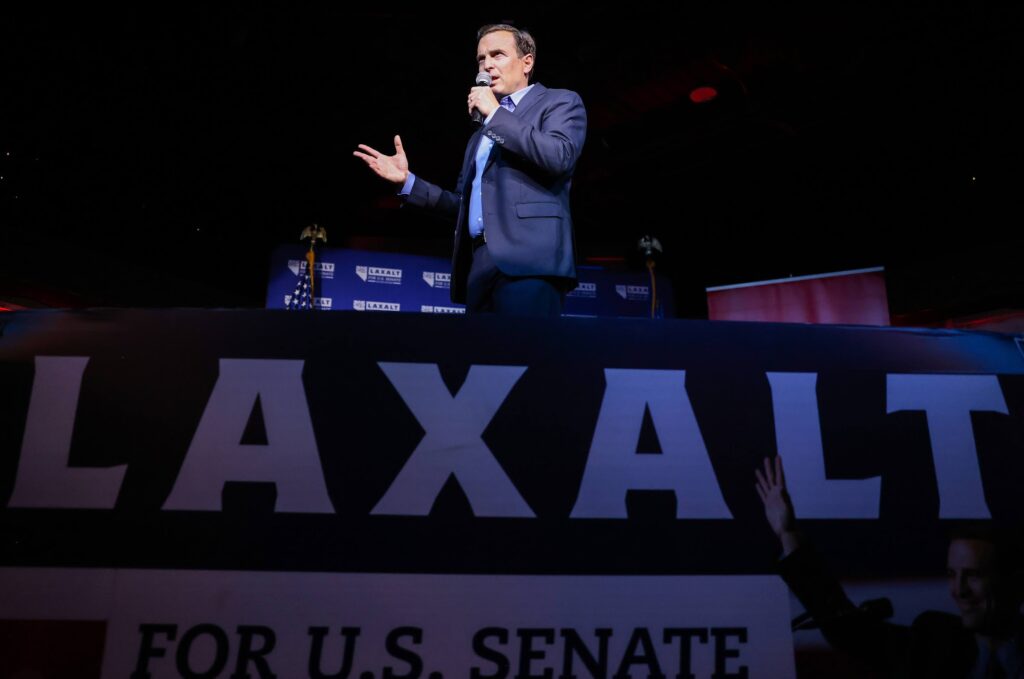
Republicans, meanwhile, have sought to directly tie energy costs to Democratic policy decisions. An ad from Club for Growth released last week, for instance, attributed higher gas prices to the move by the Biden Administration to kill the Keystone XL pipeline, an echo of statements Laxalt has made on the campaign trail for months.
Karpinski pushed back on that Republican framing — “the notion that somehow if the Keystone Pipeline were built, that our gas prices would be lower is just wrong,” he said — and Cortez Masto has separately defended legislation she backed banning certain federal oil and gas leases in northeastern Nevada.
All the same, the Republican focus on economic issues has only intensified in the final days of the election, where it has been channeled into a proxy for dissatisfaction for the Biden White House.
“Joe Biden's numbers are terrible,” Hughes said. “Even Democrats don't like the guy. They've come home a little bit now just because it's an election.”
Abortion and a fight for the suburbs
While Republicans have hammered messaging on the economy, abortion access has dominated Democratic messaging in a post-Roe v. Wade repeal America, as both candidates and outside groups have released scores of ads warning of abortion bans under a Republican-controlled Congress.
But the reality of abortion access messaging has been muddled in the months following the Supreme Court decision, especially as Nevada’s own abortion laws have opened a backdoor for Republicans looking to soften messaging on their opposition to abortion.
Nevada law protects abortion through 24 weeks, courtesy of a statute baked into place in a 1990 referendum. It would require another statewide vote to undo that basic framework.
As a result, Cortez Masto, in particular, has sought to nationalize abortion as an issue, seizing on a proposed 13-week abortion ban from Sen. Lindsey Graham (R-SC) as emblematic of the potential for some kind of national restriction being proposed under a GOP Congress and calling her opponent, Laxalt, an “automatic vote” for such a ban.
“In one fell swoop, the Supreme Court stripped women of that right, setting our country back 50 years,” Cortez Masto says directly to camera in one campaign ad. “And now, Mitch McConnell says he might go further, banning abortion nationwide, including here in Nevada.”
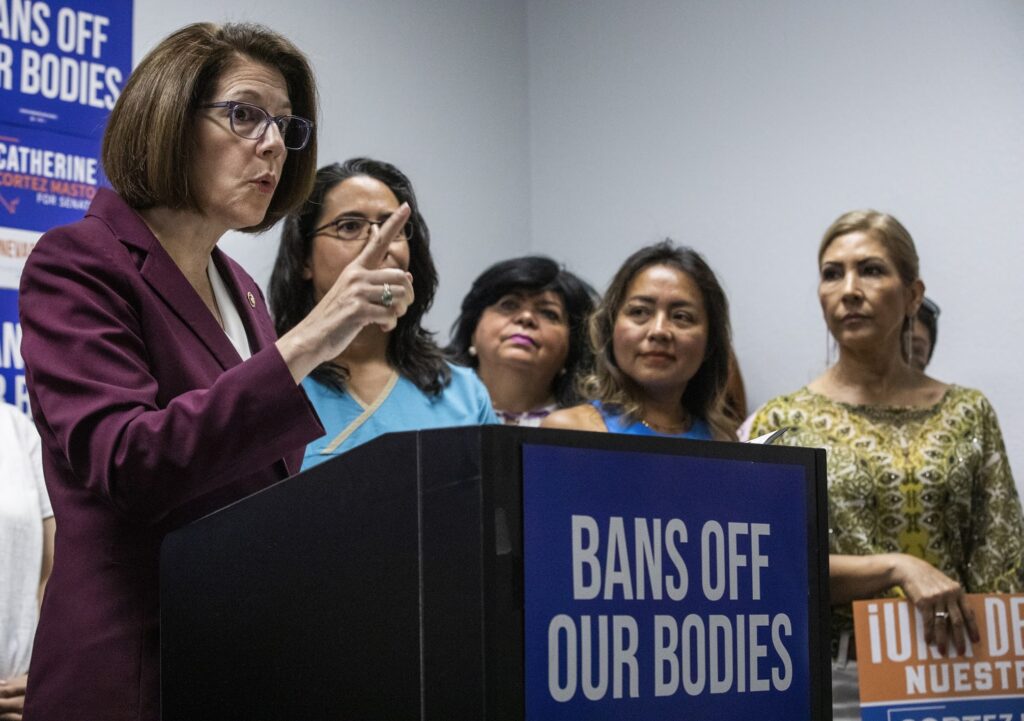
Laxalt has long publicly opposed abortion, earning the backing of the anti-abortion group National Right to Life during his Senate bid, expressing support for a potential new referendum on a 13-week abortion ban in Nevada and, as attorney general, signing on to multiple state-level lawsuits aiming to restrict abortion access in some Southern states.
But even as Laxalt has faced repeated attacks after calling the overturning of Roe “a historic victory” in a statement (and once calling the legal basis for the original decision “a joke”), he has also characterized the issue as one of states’ rights and called abortion in Nevada “settled law.”
In an op-ed in the Reno Gazette-Journal that also argued against late-term abortions, Laxalt said Cortez Masto “falsely claim[ed]” he would “favor a national abortion ban,” part of what he called a “litany of absurdities.”
And with just days before the election — and after millions of dollars in advertising spending — it remains unclear how effective abortion messaging will be.
A New York Times/Siena College poll released last week found 51 percent of Nevada respondents named economic issues as most important, compared to just 35 percent who named “societal issues,” including abortion.
Hughes, the Republican strategist, was broadly dismissive of Democratic attacks on abortion — “I don’t understand this thought process of, ‘The first 10 ads on abortion didn’t work, let’s run ad number 11.’”
Dan Lee, an associate professor of political science at UNLV, told The Nevada Independent that the issue of abortion and subsequent abortion advertisements could also be read as attempts by Democrats to keep and hold suburban white voters — especially women — who started backing the Democratic Party after 2016.
“When you look at the campaigns, how much Cortez Masto and other Democratic groups supporting her, they're really stressing abortion,” Lee said. “That is an issue that can appeal to the suburban white women voters, female voters, and because that's not really an issue that ranks high for Latino voters.”
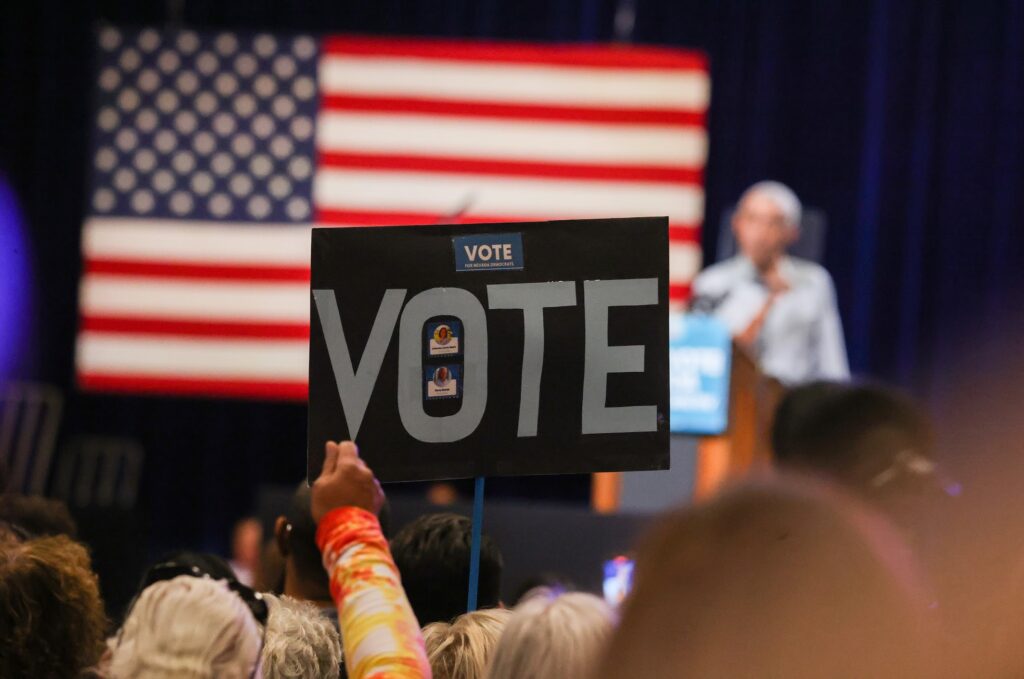
Democracy on the ballot
Lurking under the surface of the 2022 election are the ghosts of 2020.
Claims that the 2020 election was not legitimately won by President Joe Biden have continued to fester and evolve in Nevada, with some county commissions moving to end the use of electronic voting machines based on conspiracy theories, while numerous prominent election deniers are on the general election ballot.
That includes Laxalt, who helped the Trump campaign’s Nevada-based litigation following the 2020 election in bid to stop the use of signature-verification machines amid baseless claims that deceased voters had cast ballots.
On the campaign trail, Laxalt has less often revisited claims of mass voter fraud — last month, he acknowledged to the Las Vegas Review-Journal that Biden was the “legitimate president” — and more often criticized the state’s election administration, in large part by taking aim at changes Democratic lawmakers made in 2020 to create universal mail-in voting in response to the pandemic.
“They went in the middle of the night, 80 days out, and they fundamentally altered our election,” Laxalt said during a campaign event in Henderson in February. “And they did that to give Biden a better chance. They did that to change the system, to give him a leg up.”
Following TV attacks linking Laxalt’s work on the Trump campaign, election denialism more broadly and the Jan. 6 insurrection, a Laxalt spokesperson told the Reno Gazette-Journal that “He has said he’ll accept the results of this election."
But Laxalt’s role in 2020 has remained core to the Democratic attacks against him in the late stages of the campaign. At what was the only large-scale campaign rally for Democrats in the waning days of the election, former President Barack Obama told a crowd in North Las Vegas that “I think it’s fair to say that if he loses this race, he’s gonna do it again.”
“He has no actual evidence of election fraud, because there’s actually no widespread election fraud, but he’s not gonna let that stop him,” Obama said.
Whether those attacks will stick, however, remains unclear.
“In a way, it’s not that important to voters,” Lee, the UNLV political scientist, said. “Either they care more about the economy and inflation, because that actually affects their pocketbooks today, versus this abstract ideal of how our democracy should work … I think it doesn’t matter as much as we think it matters, or as much as it should matter.”
An election on the margins
With polling averages locked in the schrödinger's box of statistical margins of error, Lee also said that small deviations on the margins of the electorate could have an outsized effect on the outcome of the race.
Case in point, Lee said, would be non-major party candidates. Though they gather only marginal support — the most recent New York Times/Siena poll found the three third-party candidates cumulatively securing less than 2 percent of the vote — those candidates (or the state’s “none of these candidates” option) could still fractionally pull more from one candidate versus the other.
“In a close election that can make a difference,” Lee said. “And you look at the third-party candidates on the ballot in Nevada, and this is a pattern that we've seen over the past several election cycles, is they tend to be conservative-leaning parties.”
Clouding the analysis of partisan turnout, however, is the increasingly large swath of registered non-partisans in Nevada. Now numbering more than 517,00, there are nearly as many non-partisan voters statewide as registered Republicans (538,000), with the number increasing steadily through 2021 and 2022 following the creation of the state’s automatic voter registration law.
But, Lee said, research shows that many of these non-partisans still retain strong Democratic or Republican voting patterns — even if their registration suggests otherwise.
“A lot of those independents are closet partisans,” Lee said. “...If you push them and ask them, ‘if you have to pick and choose, who would you support,’ about a third say they're Democrats, a third say they are Republican, and a third say they are independent.”
As a result, the number of “true independents,” he said, hews closer to between 8 to 12 percent of a given electorate.
At the same time, a general increase in partisan polarization has sharply reduced ticket-splitting over time — a decrease, Lee said, that could again create outsize influence for the reduced number of voters who may split their vote between the two major parties.
“Ninety percent of Democrats vote Democrat, 90 percent of Republicans vote Republican,” Lee said. “That still suggests there's 10 percent that might be in play, that could swing one election.”
